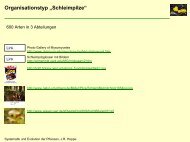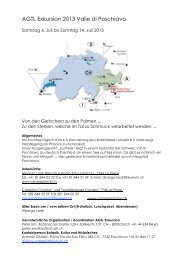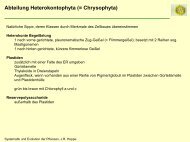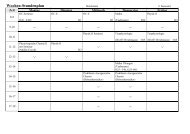Abteilung Spermatophyta (Samenpflanzen) - Biologie
Abteilung Spermatophyta (Samenpflanzen) - Biologie
Abteilung Spermatophyta (Samenpflanzen) - Biologie
Sie wollen auch ein ePaper? Erhöhen Sie die Reichweite Ihrer Titel.
YUMPU macht aus Druck-PDFs automatisch weboptimierte ePaper, die Google liebt.
<strong>Abteilung</strong> <strong>Spermatophyta</strong> (<strong>Samenpflanzen</strong>)<br />
240.000 Arten in 16.000 Gattungen<br />
davon 500 Arten Coniferophytina und 130 Arten Cycadophytina<br />
Merkmal: Samenanlage = Sporangium mit „neuer“ Schutzhülle<br />
http://www.wort-und-wissen.de/sij/sij72/img/sij72-1g.gif<br />
Systematik und Evolution der Pflanzen, J.R. Hoppe
<strong>Abteilung</strong> <strong>Spermatophyta</strong><br />
Unterabteilung: Coniferophytina<br />
Klasse Ginkgoatae<br />
Klasse Pinatae<br />
Unterklasse: Cordaitidae<br />
Unterklasse: Pinidae (= Coniferen)<br />
Unterklasse: Taxidae<br />
http://upload.wikimedia.org/wikipedia/commons/thumb/b/b7/Jingu_Gaien_Ginkgo_Street_Tokyo.jpg/800px-<br />
Jingu_Gaien_Ginkgo_Street_Tokyo.jpg<br />
Systematik und Evolution der Pflanzen, J.R. Hoppe
<strong>Abteilung</strong> <strong>Spermatophyta</strong>, UAbt. Coniferophytina<br />
Klasse Ginkgoatae<br />
Ginkgoaceae<br />
Bekannt seit dem Unterperm (Trichopitys)<br />
größte Vielfalt in Trias bis Kreide mit weltweiter Verbreitung<br />
Heute in China und in Kultur<br />
http://www.mobot.org/MOBOT/Research/APweb/<br />
http://www.mobot.org/MOBOT/Research/APweb/maps/Ginkgoaceae.gif<br />
Ginko fossil aus dem Jura von Henan, China<br />
http://www.nigpas.ac.cn/IGCP506/images/photo/Fossil%20Ginkgo%20leave%20from%20the%20Jurassic%20of<br />
%20Henan.jpg<br />
http://www.ruhr-uni-bochum.de/boga/html/Ginkgo_VK.GIF<br />
Systematik und Evolution der Pflanzen, J.R. Hoppe
<strong>Abteilung</strong> <strong>Spermatophyta</strong>, UAbt. Coniferophytina<br />
Klasse Ginkgoatae<br />
Ginkgoaceae<br />
Ginkgo:<br />
männliche Blüten<br />
weibliche Kurztriebe mit gestielten Samenanlagen<br />
gestielten Samenanlagen<br />
reife Samen<br />
http://www.mobot.org/MOBOT/Research/APweb/orders/ginkgoales.html<br />
http://arnica.csustan.edu/photos/800/Ginkgo_seeds_1.jpg<br />
http://arnica.csustan.edu/photos/800/Ginkgo_ovules_1.jpg<br />
http://arnica.csustan.edu/photos/800/Ginkgo_male_cones_1.jpg<br />
Ginkgo, Samenanlagen<br />
http://facstaff.bloomu.edu/chamuris/222/images.html<br />
http://departments.bloomu.edu/biology/pics/botany/ginkgo_mega1.jpg<br />
Systematik und Evolution der Pflanzen, J.R. Hoppe
<strong>Abteilung</strong> <strong>Spermatophyta</strong>, UAbt. Coniferophytina<br />
Klasse Ginkgoatae<br />
Ginkgoaceae<br />
Lebenszyklus<br />
Samenanlage<br />
Nucellus mit Integument, Mikropyle<br />
Pollenkammer<br />
Gametophyt in Entwicklung<br />
Ginkgo biloba, junge Samenanlage<br />
http://www.lima.ohio-state.edu/academics/biology/images/ginkgofe.jpg<br />
Systematik und Evolution der Pflanzen, J.R. Hoppe
<strong>Abteilung</strong> <strong>Spermatophyta</strong>, UAbt. Coniferophytina<br />
Klasse Ginkgoatae<br />
Ginkgoaceae<br />
Lebenszyklus<br />
Junge Samenanlage<br />
Alte Samenanlage mit entwickeltem Prothallium (= primärem Endosperm)<br />
Archegonien<br />
http://www.ucmp.berkeley.edu/IB181/VPL/CorCon/CorConP/CorCon6d.jpeg<br />
http://departments.bloomu.edu/biology/pics/botany/ginkgo_ovule_474Aw.jpg<br />
http://departments.bloomu.edu/biology/pics/botany/ginkgo_archegonium_474w.jpg<br />
Systematik und Evolution der Pflanzen, J.R. Hoppe
<strong>Abteilung</strong> <strong>Spermatophyta</strong>, UAbt. Coniferophytina<br />
Klasse Ginkgoatae<br />
Ginkgoaceae<br />
Lebenszyklus<br />
Ginkgo:<br />
Reifer Samen mit Embryo<br />
Nährgewebe: Weiblicher Gametophyt = primäres Endosperm<br />
Ginkgo: reifer Samen mit Embryo<br />
http://www.csupomona.edu/~jcclark/classes/bot125/resource/graphics/g/gin_ginkgo_embr_gam_label.jpg<br />
Systematik und Evolution der Pflanzen, J.R. Hoppe
<strong>Abteilung</strong> <strong>Spermatophyta</strong>, UAbt. Coniferophytina<br />
Klasse Ginkgoatae<br />
Ginkgoaceae<br />
Verwendung:<br />
Alternative Medizin, „Wellness“<br />
Umsatz in USA 300 Mio € / a<br />
http://www.ginkgomuseum.com/images/stern.jpg<br />
Ginkgo-Versand<br />
http://www.ginkgomuseum.com/images/ginkgoguetesiegel.jpg<br />
http://www.ginkgomuseum.com/images/shampoopd.jpg<br />
Systematik und Evolution der Pflanzen, J.R. Hoppe
<strong>Abteilung</strong> <strong>Spermatophyta</strong>, UAbt. Coniferophytina<br />
Klasse Ginkgoatae<br />
Ginkgoaceae<br />
Verwendung: Tebonin <br />
Wirkstoff:<br />
Ginkgo-biloba-Blätter-Trockenextrakt<br />
Anwendungsgebiete:<br />
Zur Behandlung von Beschwerden bei durch altersbedingte Arterienverengung hirnorganisch bedingten<br />
Leistungsstörungen im Rahmen eines therapeutischen Gesamtkonzeptes mit den Hauptbeschwerden: Rückgang der<br />
Gedächtnisleistung, Merkfähigkeit und Konzentration, Kopfschmerzen, Schwindelgefühle, Ohrensausen<br />
Hinweise:<br />
Bevor die Behandlung mit Ginkgo-Extrakt begonnen wird, sollte geklärt werden, ob die Krankheitsbeschwerden nicht<br />
auf einer spezifisch zu behandelnden Grunderkrankung beruhen.<br />
Zu Risiken und Nebenwirkungen lesen Sie die Packungsbeilage und fragen Sie Ihren Arzt oder Apotheker.<br />
Tebonin<br />
http://www.tebonin.de/tebonin/imagepool/emoHome.jpg<br />
http://www.tebonin.de/tebonin/imagepool/packung.jpg<br />
Systematik und Evolution der Pflanzen, J.R. Hoppe
<strong>Abteilung</strong> <strong>Spermatophyta</strong><br />
Unterabteilung: Coniferophytina<br />
Klasse Ginkgoatae<br />
Klasse Pinatae<br />
Unterklasse: Cordaitidae<br />
Unterklasse: Pinidae (= Coniferen)<br />
Unterklasse: Taxidae<br />
Cordaites<br />
http://images.amazon.com/images/P/B000BVYS88.01._SS500_SCLZZZZZZZ_V56968351_.jpg<br />
Systematik und Evolution der Pflanzen, J.R. Hoppe
<strong>Abteilung</strong> <strong>Spermatophyta</strong>, UAbt. Coniferophytina<br />
Klasse Pinatae, UKl. Cordaitidae<br />
waldbildend im Karbon, Aussterben im Karbon<br />
30m hohe Bäume<br />
Bandförmige, schraubig gestellt Blätter<br />
Cordaites<br />
http://www.dinosauromorpha.de/nondinosaurian/plants/cordaites.JPG<br />
Cordaites-Stamm<br />
http://members.aol.com/digmorwillis/geoffcordbg.jpg<br />
Systematik und Evolution der Pflanzen, J.R. Hoppe
<strong>Abteilung</strong> <strong>Spermatophyta</strong>, UAbt. Coniferophytina<br />
Klasse Pinatae, UKl. Cordaitidae<br />
Männliche Blüten:<br />
kurze Achsen, nach wenigen Perianthblättern Staubblätter in schraubiger Stellung<br />
Weibliche Blüten:<br />
nach Perianthblättern wenige „Fruchtblätter“ mit endständiger Samenanlage; wahrscheinlich Spermatozoide<br />
Coniferopsida<br />
http://www.biologie.uni-hamburg.de/b-online/ibc99/botanica/botanica/conifero.htm<br />
http://www.biologie.uni-hamburg.de/b-online/ibc99/botanica/botanica/bw/cordai1.gif<br />
http://www.biologie.uni-hamburg.de/b-online/ibc99/botanica/botanica/bw/cordai2.gif<br />
Cordaites pseudopluitans<br />
http://archive.1september.ru/bio/2002/02/13.gif<br />
Systematik und Evolution der Pflanzen, J.R. Hoppe
<strong>Abteilung</strong> <strong>Spermatophyta</strong>, UAbt. Coniferophytina<br />
Klasse Pinatae, UKl. Cordaitidae<br />
Cordaites<br />
Cordaites<br />
Reproductive structures of Cordaites. (A) Foliage with fertile shoots. (B) Portion of the ovulebearing<br />
Cordaianthus including part of the primary axis with ovulate secondary shoots bearing<br />
pendant ovules. (C) Pollen-bearing Cordaianthus including part of the primary axis with<br />
secondary fertile shoots, each of which is a compound structure with bracts subtending pollen<br />
organs.<br />
http://www.ucmp.berkeley.edu/IB181/VPL/CorCon/CorConD/CorConD9.gif<br />
Reconstruction of the tree growth-form of Cordaites.<br />
http://www.ucmp.berkeley.edu/IB181/VPL/CorCon/CorConD/CorConD7.gif<br />
Systematik und Evolution der Pflanzen, J.R. Hoppe
<strong>Abteilung</strong> <strong>Spermatophyta</strong>, UAbt. Coniferophytina<br />
Klasse Pinatae, UKl. Cordaitidae<br />
Schema Sporophylle / Samenanlagen der Cordaitales<br />
Ableitung der Deckschuppen/Samenschuppen-Komplexe der Coniferen<br />
Ableitung der weiblichen Blüten von Gnetum<br />
Cordaiten -> Pinus und Gnetum<br />
http://www.nibb.ac.jp/annual_report/2001/html/ann404.html<br />
http://www.nibb.ac.jp/annual_report/2001/html/images/ann404f01.gif<br />
Systematik und Evolution der Pflanzen, J.R. Hoppe
<strong>Abteilung</strong> <strong>Spermatophyta</strong>, UAbt. Coniferophytina<br />
Klasse Pinatae, UKl. Pinidae<br />
Voltziales<br />
Lebachia (B)<br />
Ernestiodendron (C)<br />
Walchiostrobus (D)<br />
Lebachia, Ernestiodendron, Walchiodendron<br />
Athough these early conifers looked modern in terms of their foliage, their cones are quite primitive and show<br />
a definite link with the cordaites. In the Lebachia cone shown at (B), a single cone scale in the complex bears<br />
a single ovule. Still more cordaitean is aspect is the ovuliferous scale at (C), an example of Ernestiodendron.<br />
Note the multiple ovules on short stalks. In the Walchiostrobus shoot at (D) the ovules are fully emergent from<br />
the sterile cone complex, borne on stalks much like the cordaitean ovules illustrated earlier.<br />
http://archive.1september.ru/bio/2002/02/13.gif<br />
Systematik und Evolution der Pflanzen, J.R. Hoppe
<strong>Abteilung</strong> <strong>Spermatophyta</strong>, UAbt. Coniferophytina<br />
Klasse Pinatae, UKl. Pinidae<br />
Voltziales<br />
Voltzia<br />
Lebachia<br />
Voltzia<br />
http://www.infovek.sk/predmety/biologia/metodicke/borovicovite/obrazky/Voltzia1.jpg<br />
Lebachia<br />
http://www.steffen-lebach.de/lebspez.jpg<br />
Systematik und Evolution der Pflanzen, J.R. Hoppe
<strong>Abteilung</strong> <strong>Spermatophyta</strong>, UAbt. Coniferophytina<br />
Klasse Pinatae, UKl. Pinidae<br />
Pinaceae<br />
Pinus aristata, Grannenkiefer<br />
Rocky Mountains<br />
- 4700 Jahre alt<br />
Pinus aristata<br />
http://www.discoverlife.org/IM/I_SB/0001/640/Pinus_aristata,Whole_tree,I_SB00104.jpg<br />
Systematik und Evolution der Pflanzen, J.R. Hoppe
<strong>Abteilung</strong> <strong>Spermatophyta</strong>, UAbt. Coniferophytina<br />
Klasse Pinatae, UKl. Pinidae<br />
Pinaceae<br />
Pinus<br />
Männliche Blüten<br />
Pinus nigra 'Oregon Green' - dry (empty) pollen strobili<br />
http://www.richmond.edu/~jhayden/conifers/pinus_nigra_'oregon_green'_2s.JPG<br />
Pinus taeda - Loblolly Pine - pollen strobili<br />
http://www.richmond.edu/~jhayden/conifers/pinus_taeda_1s.JPG<br />
Systematik und Evolution der Pflanzen, J.R. Hoppe
<strong>Abteilung</strong> <strong>Spermatophyta</strong>, UAbt. Coniferophytina<br />
Klasse Pinatae, UKl. Pinidae<br />
Pinaceae<br />
Pinus<br />
Mikrosporophyll<br />
Pinus, Mikrosporophylle<br />
http://botit.botany.wisc.edu/images/130/Gymnosperms/Coniferophyta/Pinus_Images/Microsporangiate/Male_con<br />
e_labelled_Bottom.jpg<br />
Systematik und Evolution der Pflanzen, J.R. Hoppe
<strong>Abteilung</strong> <strong>Spermatophyta</strong>, UAbt. Coniferophytina<br />
Klasse Pinatae, UKl. Pinidae<br />
Pinaceae<br />
Pinus<br />
Pollen (Mikroprothallium)<br />
Pinus, Pollen<br />
http://www.geo.arizona.edu/palynology/pinechn.gif<br />
Pinus pollen<br />
http://www.forestryimages.org/images/384x256/1373023.jpg<br />
Systematik und Evolution der Pflanzen, J.R. Hoppe
<strong>Abteilung</strong> <strong>Spermatophyta</strong>, UAbt. Coniferophytina<br />
Klasse Pinatae, UKl. Pinidae<br />
Pinaceae<br />
Pinus<br />
Pollen<br />
Pinus, Pollen<br />
http://botit.botany.wisc.edu/images/130/Gymnosperms/Coniferophyta/Pinus_Images/Microsporangiate/Pollen/lab<br />
elled_pollen_grain.jpg<br />
Systematik und Evolution der Pflanzen, J.R. Hoppe
<strong>Abteilung</strong> <strong>Spermatophyta</strong>, UAbt. Coniferophytina<br />
Klasse Pinatae, UKl. Pinidae<br />
Pinaceae<br />
Pinus nigra ‚Oregon Green‘<br />
Weiblicher Zapfen<br />
Pinus nigra 'Oregon Green' - ovulate cones shortly after pollination stage<br />
http://www.richmond.edu/~jhayden/conifers/pinus_nigra_'oregon_green'_1s.JPG<br />
Systematik und Evolution der Pflanzen, J.R. Hoppe
<strong>Abteilung</strong> <strong>Spermatophyta</strong>, UAbt. Coniferophytina<br />
Klasse Pinatae, UKl. Pinidae<br />
Pinaceae<br />
Pinus mugo<br />
Weiblicher Zapfen, Samenanlagen mit Bestäubungstropfen<br />
Pinus mugo, Bestäubungstropfen<br />
http://www.ruhr-uni-bochum.de/boga/html/Pinus.mugo.BT.st.jpg<br />
Systematik und Evolution der Pflanzen, J.R. Hoppe
<strong>Abteilung</strong> <strong>Spermatophyta</strong>, UAbt. Coniferophytina<br />
Klasse Pinatae, UKl. Pinidae<br />
Pinaceae<br />
Pinus<br />
Samenschuppe, Deckschuppe, Samenanlage, Megasporenmutterzelle, Pollen<br />
Deck- und Samenschuppe mit Samenanlage.<br />
Samen<br />
http://botit.botany.wisc.edu/images/130/Gymnosperms/Coniferophyta/Pinus_Images/Ovulate/Seedscale_complex_MC.php?x=542.97083333333&y=273.87387387387<br />
Systematik und Evolution der Pflanzen, J.R. Hoppe
<strong>Abteilung</strong> <strong>Spermatophyta</strong>, UAbt. Coniferophytina<br />
Klasse Pinatae, UKl. Pinidae<br />
Pinaceae<br />
Pinus<br />
Pollenkeimung<br />
Pinus, Pollenkeimung<br />
http://www.lima.ohio-state.edu/academics/biology/images/fcone10.jpg<br />
Systematik und Evolution der Pflanzen, J.R. Hoppe
<strong>Abteilung</strong> <strong>Spermatophyta</strong>, UAbt. Coniferophytina<br />
Klasse Pinatae, UKl. Pinidae<br />
Pinaceae<br />
Pinus<br />
Samenanlage,<br />
- Bildung des Megaprothalliums,<br />
- Embryobildung, 1. Teilung<br />
Pinus, nucleäres Megaprothallium<br />
http://departments.bloomu.edu/biology/pics/botany/B505A_low_mag1w.jpg<br />
Pinus, Proembryo, 1. Teilung<br />
http://departments.bloomu.edu/biology/pics/botany/B506A_lomagw.jpg<br />
Systematik und Evolution der Pflanzen, J.R. Hoppe
<strong>Abteilung</strong> <strong>Spermatophyta</strong>, UAbt. Coniferophytina<br />
Klasse Pinatae, UKl. Pinidae<br />
Pinaceae<br />
Pinus<br />
Weiblicher Zapfen längs<br />
Samenanlage mit Prothallium und Archegonien<br />
Pinus, Zapfen längs<br />
http://botit.botany.wisc.edu/images/130/Gymnosperms/Coniferophyta/Pinus_Images/Ovulate/LS_ovulat<br />
e_cone_MC_.jpg<br />
Pinus, Archegonien<br />
http://www.lima.ohio-state.edu/academics/biology/images/femcone8.jpg<br />
Systematik und Evolution der Pflanzen, J.R. Hoppe
<strong>Abteilung</strong> <strong>Spermatophyta</strong>, UAbt. Coniferophytina<br />
Klasse Pinatae, UKl. Pinidae<br />
Pinaceae<br />
Pinus<br />
Samenanlage, Gametophyt mit Archegonien<br />
Pinus, Samenanlage mit Archegonien<br />
http://www.lima.ohio-state.edu/academics/biology/images/femcone7.jpg<br />
Systematik und Evolution der Pflanzen, J.R. Hoppe
<strong>Abteilung</strong> <strong>Spermatophyta</strong>, UAbt. Coniferophytina<br />
Klasse Pinatae, UKl. Pinidae<br />
Pinaceae<br />
Pinus, Lebenszyklus<br />
Pinus, Lebenszyklus<br />
http://hypnea.botany.uwc.ac.za/phylogeny/bioCycles/images/pine-cycle.gif<br />
Systematik und Evolution der Pflanzen, J.R. Hoppe
<strong>Abteilung</strong> <strong>Spermatophyta</strong>, UAbt. Coniferophytina<br />
Klasse Pinatae, UKl. Pinidae<br />
Pinaceae<br />
Zapfenentwicklung<br />
Pinus Zapfen<br />
http://botit.botany.wisc.edu/images/130/Gymnosperms/Coniferophyta/Pinus_Imag<br />
es/Ovulate/Series_red_pine_MC.jpg<br />
Systematik und Evolution der Pflanzen, J.R. Hoppe
<strong>Abteilung</strong> <strong>Spermatophyta</strong>, UAbt. Coniferophytina<br />
Klasse Pinatae, UKl. Pinidae<br />
Pinaceae<br />
Larix decidua<br />
Männl. Blüte<br />
Zapfen: Deckschuppe sichtbar<br />
Larix decidua<br />
http://web.ujf-grenoble.fr/JAL/actu/imaprin2/larix.jpg<br />
Systematik und Evolution der Pflanzen, J.R. Hoppe
<strong>Abteilung</strong> <strong>Spermatophyta</strong>, UAbt. Coniferophytina<br />
Klasse Pinatae, UKl. Pinidae<br />
Araucariaceae (33 Arten)<br />
Seit der Trias auch in Europa und Grönland, heute südliche Erdhälfte<br />
Holzige Zapfen mit 1samigen Deck-Samenschuppen-Komplexen<br />
Araucarioide Tüpfelung des Holzes (= alternierende Tüpfelung der Tracheiden)<br />
http://www.mobot.org/MOBOT/Research/APweb/maps/Araucariaceae.gif<br />
Systematik und Evolution der Pflanzen, J.R. Hoppe
<strong>Abteilung</strong> <strong>Spermatophyta</strong>, UAbt. Coniferophytina<br />
Klasse Pinatae, UKl. Pinidae<br />
Araucariaceae<br />
Arauccaria araucana<br />
Arauccaria araucana<br />
http://www.ruhr-uni-bochum.de/boga/html/Araucaria.araucana.ja11.JPG<br />
Araucaria araucana<br />
http://www.conifers.co.nz/araucaria/Aaraucana.jpg<br />
Systematik und Evolution der Pflanzen, J.R. Hoppe
<strong>Abteilung</strong> <strong>Spermatophyta</strong>, UAbt. Coniferophytina<br />
Klasse Pinatae, UKl. Pinidae<br />
Araucariaceae<br />
Araucaria angustifolia, Habitus und Zapfen<br />
Araucaria bidwilli<br />
Araucaria angustifolia<br />
http://www.caraguata.com.br/Fotos/Photo6.jpg<br />
Araucaria angustifolia, Zapfen<br />
http://www.roland-mecke.de/images/prevs/prev4.jpg<br />
Araucaria bidwilli<br />
http://science.uniserve.edu.au/school/curric/stage4_5/nativeplants/gallery/bunya/bunyacone.jpg<br />
Systematik und Evolution der Pflanzen, J.R. Hoppe
<strong>Abteilung</strong> <strong>Spermatophyta</strong>, UAbt. Coniferophytina<br />
Klasse Pinatae, UKl. Pinidae<br />
Cupressaceae (incl. Taxodiaceae) 113 Arten + 14<br />
Arten<br />
Nadelblätter � Schuppenblätter<br />
Gegenständig oder in 3er-Wirteln<br />
Europa nur heimisch: Juniperus<br />
Oft mehr als 2 aufrechte (atrope) Samenanlagen pro<br />
verwachsenem Deck-Samenschuppen-Komplex<br />
Blätter schraubig, holzige Zapfen<br />
Ehem. Taxodiaceae:<br />
Metasequoia 140 in China entdeckt, im Herbst<br />
abfallende Kurztriebe<br />
Taxodium mit Wurzelknie und ebenso mit abfallenden<br />
Kurztrieben<br />
Cupressaceae (inkl. Taxodiaceae)<br />
http://www.mobot.org/MOBOT/Research/APweb/maps/Cupressaceae.gif<br />
Systematik und Evolution der Pflanzen, J.R. Hoppe
<strong>Abteilung</strong> <strong>Spermatophyta</strong>, UAbt. Coniferophytina<br />
Klasse Pinatae, UKl. Pinidae<br />
Cupressaceae (incl. Taxodiaceae)<br />
Thujoideae<br />
Thuja standishii<br />
Schuppenzapfen<br />
Thuja standishii (Gordon) Carrière<br />
http://www.boga.ruhr-uni-bochum.de/html/Thuja.standishii.BGBO.ja2.jpg<br />
http://www.boga.ruhr-uni-bochum.de/html/Thuja.standishii.BGBO.ja.jpg<br />
Systematik und Evolution der Pflanzen, J.R. Hoppe
<strong>Abteilung</strong> <strong>Spermatophyta</strong>, UAbt. Coniferophytina<br />
Klasse Pinatae, UKl. Pinidae<br />
Cupressaceae (incl. Taxodiaceae)<br />
Cupressoideae<br />
Chaemaecyparis lawsoniana, Habitus<br />
Cupressus arizonica, reifer Kugelzapfen<br />
Kugelzapfen<br />
Chamaecyparis lawsoniana, Habitus<br />
http://www.aphotoflora.com/Chamaecyparis%20lawsoniana-tree-21-09-04.jpg<br />
Cupressus arizonica, reife Zapfen<br />
http://www.ruhr-uni-bochum.de/boga/html/Cupressus_arizonica_Fastigiata.JPG<br />
Systematik und Evolution der Pflanzen, J.R. Hoppe
<strong>Abteilung</strong> <strong>Spermatophyta</strong>, UAbt. Coniferophytina<br />
Klasse Pinatae, UKl. Pinidae<br />
Cupressaceae (incl. Taxodiaceae)<br />
Juniperoideae<br />
Juniperus communis<br />
Beerenzapfen<br />
Juniperus communis<br />
http://www.muhlenberg.edu/cultural/graver/Collections/Conifers/Juniperus/Juniperus%20communis.JPG<br />
Juniperus communis<br />
http://linnaeus.nrm.se/flora/barr/cupressa/junip/junicom3.jpg<br />
Systematik und Evolution der Pflanzen, J.R. Hoppe
<strong>Abteilung</strong> <strong>Spermatophyta</strong>, UAbt. Coniferophytina<br />
Klasse Pinatae, UKl. Pinidae<br />
Cupressaceae (incl. Taxodiaceae)<br />
Taxodium distichum<br />
Sumpfwälder an der Nordküste des Golfes von Mexiko<br />
Wurzelknie<br />
Taxodium distichum<br />
http://www.mushroomexpert.com/trees/taxodium_distichum_01big.jpg<br />
Taxodium distichum, Wurzelknie<br />
http://claycoleman.tripod.com/760bbd20.jpg<br />
Systematik und Evolution der Pflanzen, J.R. Hoppe
<strong>Abteilung</strong> <strong>Spermatophyta</strong>, UAbt. Coniferophytina<br />
Klasse Pinatae, UKl. Pinidae<br />
Cupressaceae (incl. Taxodiaceae)<br />
Taxodium distichum, abfallende Kurztriebe<br />
Taxodium mucronatum: Mexikanische Sumpfzypresse oder Montezuma-Zypresse (Taxodium mucronatum)<br />
Dieses Exemplar - nach Stammdurchmesser der dickste Baum der Welt - steht in der Ortschaft Santa Maria<br />
del Tule in der Provinz Oaxaca, Mexiko und wird "El Gigante" (span.: der Riese) oder "Baum von Tule"<br />
genannt.<br />
Taxodiumn distichum, Blätter<br />
http://www.sbs.utexas.edu/bio406d/images/pics/cup/Taxodium%20distichum%20falllvs.jpg<br />
Taxodium mucronatum<br />
http://upload.wikimedia.org/wikipedia/commons/d/d8/Mexico.Oaxaca.ArbolTule.01.jpg<br />
Systematik und Evolution der Pflanzen, J.R. Hoppe
<strong>Abteilung</strong> <strong>Spermatophyta</strong>, UAbt. Coniferophytina<br />
Klasse Pinatae, UKl. Pinidae<br />
Cupressaceae (incl. Taxodiaceae)<br />
Sequoiadendron giganteum<br />
Sierra Nevada, Alter bis über 3000 Jahre<br />
Sequoiadendron giganteum<br />
http://www.rz.uni-karlsruhe.de/~db26/Fotos-Knoch/Sequoiadendron%20giganteum%20Mammutbaum%201.jpg<br />
Sequoiadendron giganteum<br />
http://www.forestryimages.org/images/768x512/1118238.jpg<br />
Systematik und Evolution der Pflanzen, J.R. Hoppe
<strong>Abteilung</strong> <strong>Spermatophyta</strong>, UAbt. Coniferophytina<br />
Klasse Pinatae, UKl. Pinidae<br />
Cupressaceae (incl. Taxodiaceae)<br />
Metaseqioia glyptostroboides<br />
Abfallende Kurztriebe<br />
1940 in China entdeckt<br />
Metasequoia glyptostroboides<br />
http://english.kbs.co.kr/ICSFiles/thumbnail/2005/12/22/dica44.jpg<br />
Metasequoia glyptostroboides<br />
Blätter<br />
http://maven.smith.edu/~phyllo/OldFiles/Images/Gallery/Metasequoia4.jpg<br />
Zapfen<br />
http://maven.smith.edu/~phyllo/OldFiles/Images/Gallery/Metasequoia2.jpg<br />
Systematik und Evolution der Pflanzen, J.R. Hoppe
<strong>Abteilung</strong> <strong>Spermatophyta</strong>, UAbt. Coniferophytina<br />
Klasse Pinatae, UKl. Pinidae<br />
Sciadopityaceae<br />
Monotypisch, endemisch für Japan<br />
Nadelförmige Phyllocladien<br />
Sciadopitys verticillata<br />
Sciadopitys verticillata<br />
http://www.pinetum.org/canon/SCvert12.jpg<br />
Sciadopitys verticillata<br />
http://www.ponnitai.com/database/sciadopitys/verticillata/s_verticillata1.jpg<br />
Sciadopitys, Verbreitung<br />
http://www.mobot.org/MOBOT/Research/APweb/maps/Sciadopitys.gif<br />
Systematik und Evolution der Pflanzen, J.R. Hoppe
<strong>Abteilung</strong> <strong>Spermatophyta</strong>, UAbt. Coniferophytina<br />
Klasse Pinatae, UKl. Pinidae<br />
Podocarpaceae (160)<br />
Tropische und subtropische Gebirgswälder der südlichen Hemisphäre<br />
Samenschuppe mit einseitiger, fleischiger Samenhülle (Epimatium)<br />
Podocarpus elatus<br />
http://www.brisrain.webcentral.com.au/old_site/database/Podoc_elatus1.jpg<br />
http://www.brisrain.webcentral.com.au/old_site/database/Podoc_elatus2.jpg<br />
http://www.mobot.org/MOBOT/Research/APweb/maps/Podocarpaceae.gif<br />
Systematik und Evolution der Pflanzen, J.R. Hoppe
<strong>Abteilung</strong> <strong>Spermatophyta</strong>, UAbt. Coniferophytina<br />
Klasse Pinatae, UKl. Pinidae<br />
Podocarpaceae<br />
Podocarpus macrophyllus (r)<br />
Podocarpus neriifolius (l)<br />
Podocarpus macrophyllus<br />
http://upload.wikimedia.org/wikipedia/commons/thumb/a/aa/Podocarpus_macr<br />
ophyllus_inumaki.JPG/800px-Podocarpus_macrophyllus_inumaki.JPG<br />
Podocarpus neriifolius<br />
http://upload.wikimedia.org/wikipedia/commons/thumb/9/99/Podocarpus_neriif<br />
olius.jpg/450px-Podocarpus_neriifolius.jpg<br />
Systematik und Evolution der Pflanzen, J.R. Hoppe
<strong>Abteilung</strong> <strong>Spermatophyta</strong>, UAbt. Coniferophytina<br />
Klasse Pinatae, UKl. Pinidae<br />
Phyllocladaceae<br />
Breite lappige Phyllokladien<br />
Phyllocladus asplenifolius<br />
Celery Top Pine<br />
Phyllocladus asplenifolius<br />
http://www.forestserviceni.gov.uk/our_forests/castlewellan/arboretum/2003/december/pasplenifolius.jpg<br />
Phyllocladus asplenifolius<br />
http://rigozzi.com/z_celery.jpg<br />
Phyllocladaceae<br />
http://www.mobot.org/MOBOT/Research/APweb/maps/Phyllocladaceae.gif<br />
Systematik und Evolution der Pflanzen, J.R. Hoppe
<strong>Abteilung</strong> <strong>Spermatophyta</strong>, UAbt. Coniferophytina<br />
Klasse Pinatae, UKl. Pinidae<br />
Phyllocladaceae<br />
Phyllocladus toatoa<br />
Phyllocladus toatoa<br />
http://www.sbs.auckland.ac.nz/info/schools/nzplants/images/gym/phyll_toa3(400).jpg<br />
http://www.sbs.auckland.ac.nz/info/schools/nzplants/images/gym/phyll_toa5(400).jpg<br />
Systematik und Evolution der Pflanzen, J.R. Hoppe
<strong>Abteilung</strong> <strong>Spermatophyta</strong>, UAbt. Coniferophytina<br />
Klasse Pinatae, UKl. Pinidae<br />
Cephalotaxaceae ( 4 Arten)<br />
Himalaya und Ostasien<br />
Seitenständige Samenanlagen / Blüten<br />
Cephalotaxus.harringtonia<br />
Cephalotaxus.harringtonia<br />
http://www.conifers.org/ce/ce/har2.jpg<br />
Cephalotaxus.harringtonia<br />
http://www.boga.ruhr-uni-bochum.de/html/Cephalotaxus.harringtonia.PaK.JPG<br />
http://www.mobot.org/MOBOT/Research/APweb/maps/cephalotaxaceae.gif<br />
Systematik und Evolution der Pflanzen, J.R. Hoppe
<strong>Abteilung</strong> <strong>Spermatophyta</strong>, UAbt. Coniferophytina<br />
Klasse Pinatae, UKl. Taxidae<br />
Taxaceae (20 Arten)<br />
Fast nur nordhemispärisch<br />
Männlich: schildförmige Staubblätter<br />
Samenanlagen endständig an Kurztrieben 2. Ordnung; Arillus (= Samenmantel)<br />
Taxus baccata<br />
Taxus baccata, Balderschwang, 2000-4000 Jahre alt<br />
http://www.balderschwang.de/se_data/_filebank/balderschwang/motive/gross/__dorf_eibe1.jpg/769.jpg<br />
Eibe<br />
http://www.schreiner-seiten.de/holzarten/images/eibe-holz.jpg<br />
Taxaceae<br />
http://www.mobot.org/MOBOT/Research/APweb/maps/Taxaceae.gif<br />
Systematik und Evolution der Pflanzen, J.R. Hoppe
<strong>Abteilung</strong> <strong>Spermatophyta</strong>, UAbt. Coniferophytina<br />
Klasse Pinatae, UKl. Taxidae<br />
Taxaceae<br />
Taxus baccata<br />
Männliche Blüten, schildförmige<br />
Staubblätter<br />
Taxus baccata, männliche Blüten<br />
http://www.hlasek.com/foto/taxus_baccata_aa4922.jpg<br />
Systematik und Evolution der Pflanzen, J.R. Hoppe
<strong>Abteilung</strong> <strong>Spermatophyta</strong>, UAbt. Coniferophytina<br />
Klasse Pinatae, UKl. Taxidae<br />
Taxaceae<br />
Taxus baccata<br />
Samenanlage mit Arillus<br />
Taxus baccata<br />
Samenanlage mit Arillus<br />
http://www.bio.brandeis.edu/fieldbio/medicinal_plants/images/e_yew_berry_full.jpg<br />
Systematik und Evolution der Pflanzen, J.R. Hoppe
















